|
|
|
|
|
Cheers to our "talented" literature prize awardee. Your pain his gain !!!
|
|
|
EGY.COM - LANDMARKS - CAIRO - HELIOPOLIS
|
|
by Samir Raafat
Egyptian Mail, May 27, 1995
Most shoppers knew that John Davies Bryan owned one of Cairo's leading stores in the 1880s. What they failed to understand was why a Welsh Taffy from the hills of North Wales had come to Egypt.
English, Irish and Scotsmen were no strangers to colonial Egypt. No sooner had Britain defeated Orabi Pasha at Tal Al Kebir in 1882 and it was just a matter of time for St. Andrews' schools and churches to appear in Cairo and Alexandria. Next came the St. Patrick's Day celebrations fueled by a surplus of teachers and nurses from Dublin. But when it came to Wales, not much there. It was only after the British left Egypt in 1955 that we learned of Welsh rare bits, Laura Ashley's floral prints and superstar Richard Burton.
The more politically minded however recall with desolation the Welsh-born Prime Minister Lloyd George whose government offered the Jews a homeland in Arab Palestine.
And while Eurojews anticipated their "promised land," Welsh Taffies were abandoning theirs, migrating to rural Australia and South America.
Trade and commerce were never big in Wales so that whenever a successful shopkeeper left it was a sad day. A sad day as well when John Davies Bryan decided to relocate in Egypt.
Health problems and encouragement from a relation in Egypt brought the eldest son of Edward and Elinor Bryan of Caernarfon to the shores of Alexandria where a cousin, Samuel Evans, worked for the khedivial government as chief of the Egyptian Coastal Service. In his spare time Evans dealt in the buying and selling of camels.
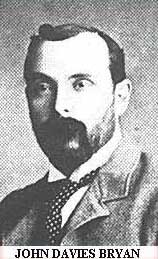 In Wales, John Davies Bryan, eldest of four brothers, had run a small shop at No. 12 Bridge Street, Caernarfon. Therefore shortly after he disembarked in Egypt he did what he knew best. He opened a shop in Cairo's Continental Hotel under the trademark name of Davies Bryan.
In Wales, John Davies Bryan, eldest of four brothers, had run a small shop at No. 12 Bridge Street, Caernarfon. Therefore shortly after he disembarked in Egypt he did what he knew best. He opened a shop in Cairo's Continental Hotel under the trademark name of Davies Bryan.
Bryan's shop sold an array of imported goods including men and ladies hats, travel gear, draperies, hosiery and shoes. His fixed price policy in a market that centered on haggling and bargaining eventually earned him his sterling reputation.
As business expanded, Bryan sent for two of his brothers, Edward and Joseph. Together in Alexandria they opened a large store on Cherif Pasha Street, which was second to none in terms of commercial location. While refurbishing their building the brothers sought the advice of architect Robert Williams and at the latter's recommendation, redecorated the facade with polished red granite from Aberdeen, and Doulting freestone from Sommerstshire.
Likewise in Cairo the Bryans commissioned Williams to design the St. David that was completed in 1910. Named after the patron saint of Wales, the tall redbrick building stood on a large piece of property purchased from Karl H. Beyerlé, the director of the Credit Foncier Bank just across the street.
Soon enough, Davies Bryan of Cairo was the pride of Sharia Emad Al Din where most elegant shops were situated. The largest of its kind, the new store occupied 1900 square meters fronting three streets: Magrabi (now Adly), Mohammed Farid (ex-Emad Al Din) and Al Manakh (now Abdel Khalek Sarwat). At just above eye level, the store's facade was decorated with ornate stucco motifs. One can still make out shields with roses, thistles, shamrocks and leeks. While most shields are engraved with the initials 'D', 'B', 'MGA', 'EJ' and 'AB', two of them have 'Davies Bryan 1910' written on them in Arabic and in English.
A larger shield overlooking Mohammed Farid Street sports the following inscriptions.
These are Welsh words for 'truth against the world.' Another shield has three lines drawn on it, one vertical and two diagonal / | \ . This is the logo of the Welsh National Gorsedd of Bards (or Eisteddfod), an important annual Welsh cultural festival.
It would be three decades later that an Eisteddfod took place in Cairo. This was on September 21, 1943 when Egypt was home to thousands of Allied soldiers including several Welsh regiments.
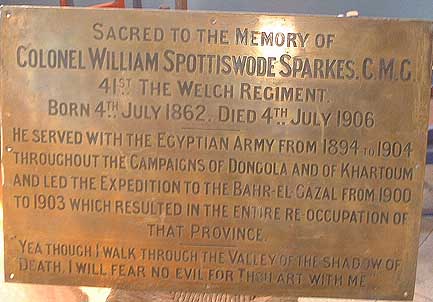
No less than 200 Welsh servicemen dressed in bardic robes attended the Cairo Eisteddfod. It was held a few blocks from the St. David in a cinema theater (now garage) off Sharia Soliman Pasha. Requisitioned during World War 2 the theater was where Lady Dorothea, wife of Cairo Police Chief Sir Thomas Russell Pasha, launched Music for All, a benevolent wartime organization for the benefit of the Allied troops.
It was also at the Cairo Eisteddfod that Enfys was launched. At first known simply as Seren y Dwyrain, the tiny wartime Welsh-language journal became the Yr Enfys in Wales which today serves an expanding overseas Welsh audience.
Today's Welsh visitors may remark that several of the shields above the St. David's main entrance were painted over with the inscriptions 'Chourbagui.' In order to explain this aberration one must go back in time and follow the sequence of events that transferred the St. Davis from the Bryans to the present owner.
First to go was John Davies Bryan who died of typhoid at age 33 on November 13, 1888. During his relatively short Egypt sojourn, John kept up a prolific correspondence with the folk back home, most of it in Welsh. These contained his impressions on Egypt, some of which were published in Genedl and later appeared in book form, a copy of which can be found at the Welsh National Library under O'r Aifft (From Egypt).
On the morning of May 13, 1920, it was the youngest brother, Robert Bryan, 61, who passed away while in residence at the St. David. Never directly involved in the family business, he was the family's educated poet and musician which explains why he bequeathed to his alma mater, the University of Aberystwyth, the sum of 2000 pounds sterling for the establishment of a music scholarship. While in Egypt Robert translated proverbs and pharaonic poems one of which originated in an ancient tomb belonging to King Tehwiti-mes of the 18th Dynasty
Edward Bryan, the second of the four brothers, died in Alexandria in 1929, leaving a large sum for the Young Men's Christian Association. It is no coincidence that Cairo's YMCA branch was located in the St. David a few floors above Pension Wales.
Last to go was Joseph Bryan. He died in 1935 at age 71 leaving the sum of 5000 pounds sterling to the Library of Wales at Aberystwyth. Back in 1928 he had donated 85 acres on a hill above the town for the erection of new educational buildings. Between 1923-4, Joseph Bryan was president of both the Alexandria British Association and the British Chamber of Commerce. In his spare time he wrote several articles including 'The Victory of Islam' (Buddugoliaeth Gyntaf Islam); 'Mohammed and the Jews and Christians' (Mohammed a'r Iddewon a'r Cristnogion); and on 'The Fate of the Jews of Medina' (Tynged Iddewon Medina).
After Joseph's death Davies Bryan & Co. gradually wound up its activities in Egypt so that by the time the Welsh regiments arrived in World War 2 they found a downsized version of what their predecessors had seen in the previous war. Another Welshman, this time from Coedpoeth, ran the store. Fred Purslow had been chief account for the Bryans brothers before buying a share in the business in 1929. It was mostly thanks to him and his associate Moise Meriems that the trade name of Davies Bryan & Co. lived on until the 1950s.
What had once been a megastore slowly imploded into several smaller shops and boutiques including Stephenson's Pharmacy and the Anglo Bookstore. In 1957 or thereabouts, three prosperous Syrian brothers-the Chourbaguis, purchased the St. David along with sundry relics left behind by their four Welsh predecessors.
Following the demise of Egypt's private sector in 1961 the St. David was taken over by a state owned insurance company. From then on the building slipped into steady decline, its main halls and entrances acquiring their gothamesque character. Thus ended Egypt's Welsh connection.
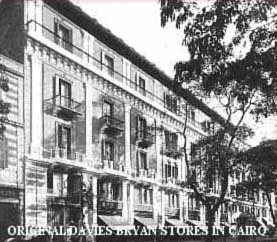
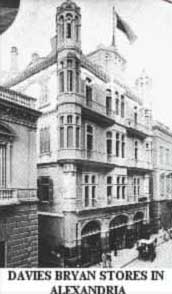
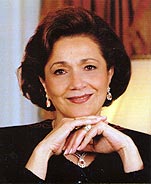
|
|
|
|
|
|
|